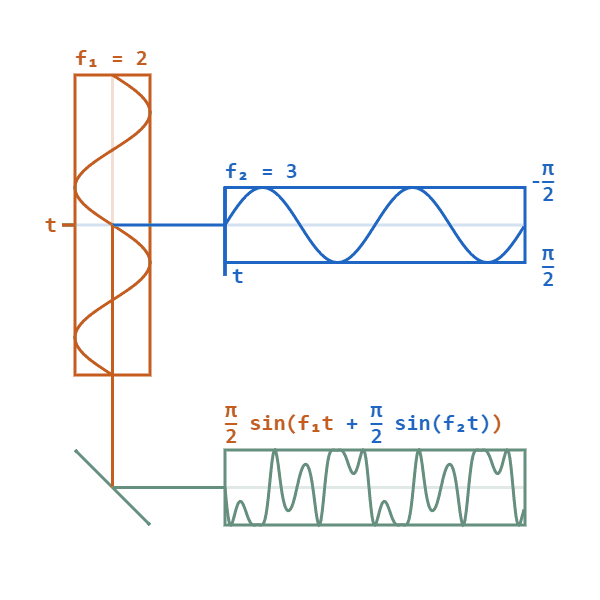If you use a radio you must have heard the terms FM and AM. Ever wondered how two radio stations have a different address on the FM scale? The radio waves travel from the radio station to your position in a different form than they actually have. This is a modulation. The need for modulation arises because of various factors. Let us see what they are!
Suggested Videos
Modulation
We all know that most signals generated in everyday life are sinusoidal waveforms. Modern signals include the basic sinusoidal form signal containing important information. Modulation is the branch of science in electronics and communication systems including varying the fundamental properties of the basic signal by superimposing it with a carrier signal to carry the signal from one location to the other. This process is ‘Modulation’.

At the receiver, the base signal regenerates by removing the carrier signal and filtering the signal to remove any unwanted noise. This process is ‘Demodulation’. The most common types of Modulation include:
Browse more Topics under Communication Systems
- asic Terminology Used in Communication Systems
- Propagation of Electromagnetic Wave
- Bandwidth of Signals
- Bandwidth of Transmission Medium
- Amplitude Modulation
- Production of Amplitude Modulated Wave
- Detection of Amplitude Modulated Wave
- Amplitude Modulation: The modulation in where the amplitude of the base signal changes or modulates by superimposing it with a carrier signal of a different amplitude and same frequency as the base signal.

- Frequency Modulation: The modulation in where the frequency of the base signal changes by superimposing it with a carrier signal having a different frequency is Frequency Modulation.

- Phase Modulation: The modulation in where the phase of the carrier signal modifies by superimposing it with a carrier signal is Phase Modulation.

Need for Modulation
We live in an electric age where the world is connected for every person, without the need of being actually connected with the help of wires. Messages, information, and signals are sent from one part of the world to the other within minutes and seconds.
All of this is possible only with the help of signals from one device to the other from one location to another one, miles away and the quantity and dependence on these signals and their inter-conversions are humongous.
You can download Communication Systems Sheet by clicking on the download button below

Stages of Modulation
- Consider the everyday example of an individual using their phone to call his/her friend for a chat. The words they speak create a vibration in the mikes generating a sinusoidal wave as the string or surface vibrates due to the difference in pressure as the words come out.
- This is the first stage of the inter-conversion of signals.
- Next, string motion converts the analog signal to digital to generate current flow on a switch going on and off. This is the second stage. The phone transmits this signal by modulating it with help of a carrier signal so as to provide it with a bandwidth for transmission and it is sent to a nearby tower for sending it over larger distances.
- Again the receiver receives the signal as it needs to be demodulated and filtered for regenerating its original content.
Uses of Modulation
Most of the times, Modulation is used for interconversion of signals from one form to another and you will be surprised to know how often this takes place in daily life let alone the scope and huge numbers that it encompasses.
- Analog Modulation looks to transfer a low baseband or bandwidth signals like a radio or TV signal over either a higher baseband /bandwidth or over a limited frequency bandwidth channel like cable TV or DTH.
- Digital Modulation, on the other hand, looks to transfer digital signals over analog baseband.
Another important use of modern modulation techniques is to carry out Frequency Division Multiplexing also known as FDM for simultaneous transfer of several signals over different frequencies in ether directions using modulation with different frequencies across the same channel.
Another use of modulation in current times is its applications in Music. Modern musical instruments often use synthesizers to generate and modify signals over different frequencies, superimpose them or demodulate i.e. differentiate these frequencies to create surreal effects that many people enjoy.
Modern modulator devices or modems( short for modulator and demodulators) perform a variety of functions some of which include :
- Grouping various signals with similar frequencies to transmit them over similar bandwidths.
- Amplification of base frequencies to improve the quality of transmission.
- Convert digital signals to analog and vice versa.
Thus, in this discussion, we briefly over-viewed the concept of modulation of signals, studied various commonly used types of modulation. We have studied the applications of Modulation and the results obtained by using it. We have also seen the scope and variation of applications of modulations used in daily life in large numbers.
Solved Question For You
Q. The process of translating the information contained by the low baseband signal to high frequencies is
- Detection
- Modulation
- Amplification
- Demodulation
Answer: B. Modulation low-frequency signals superimpose high-frequency signals.






Leave a Reply